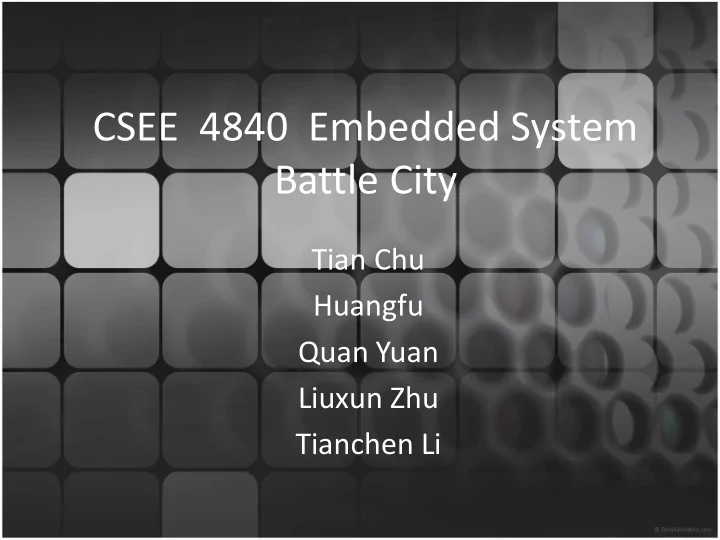

CSEE 4840 Embedded System Battle City Tian Chu Huangfu Quan Yuan Liuxun Zhu Tianchen Li
Overview • Game play – One player – Three stages (more can be easily added) – Two modes: “easy”(E) and “crazy”(C) • Keyboard control – Move: “A,S,W,D” – Fire: “Space” – Start game: “Enter”
Design Architecture
Software Design Start Scenario initialization no yes Any key pushed? Update the bullets’ Which Key? positions fire move no Update the players’ Any objects hit? Fire a bullet tanks’ positions yes Update sprites and display animation
Software Design • Sprites are stored in integers: X Y Types Color 23-15 14-6 5-2 1-0 • Backgrounds are split into 13 by 13 blocks, and each of them is stored in an integer: X Y Blocks Type 14 13 12 11 10 9 8 7 6 5 4 3 2 1 0 15
• Main Tasks - Load the scenario setup and locate images on the screen. - Adjust the tanks and bullets’ positions - Handle the overlapping problem VGA - Display animations Design
• VGA Architecture VGA Design
• Image Processing: The user screen is divided into 169 squares, each column or row contains 13 squares as indicated below: Store in array VGA Design
• Image Processing: The game scenario is constructed by 169 different images that loaded from RAM. VGA_Controller will determine each image and its position. VGA Design
• Image type: - Static Scenario VGA Static Scenarios are predefined before the game starts. Software controls the scenario mapping and send massages to VGA_Driver. Then location information will be stored in Design RAM and we only focus on the changes after scenario initialization.
• Image type: - Sprites VGA Former method for static scenario is impractical. To locate the sprites, we use the left top point and image Design length and width.
• Image Processing: The sub-image is formed by 36X36 pixels. The image below is the tank image. VGA Design
• Animation Effect: To achieve explosion effect, two explosion images of different sizes are used as frames. Display the two images in different clock periods and the VGA dynamic effect will be shown. Design
• Overlapping issue: - Set the overlapping area of upper layer to black. - Judge the color of image, if it is black, write the data of lower layer to the non-overlapping area. VGA Design
• Color conversion: Pixels of tank are represented by 24-bits. The color information stored of tanks occupied a large space of memory. Since the appearances of player tank and enemy are the same, color conversion is implemented to save memory space. VGA Design
• Data Compression 1- bit representation: 2- bit representation: VGA Design Reduced size:
• Color conversion: Pixels of tank are represented by 24-bits. The color information stored of tanks occupied a large space of memory. Since the appearances of player tank and enemy are the same, color conversion is implemented to save memory space. VGA Design
• Audio architecture Output WM 8731 data Preloaded Audio_Driver sound,ROM Audio Audio_Controller Design Audio Commend Avalon Bus
• 2 kinds of music Welcome music • composed of sin wave with different frequency. • Using sin wave data in Lab 3 Sound effect • fire and explosion. Audio • convert wave to mif, save and play. • using adder at output to play two kinds of sound effect Design simultaneously if needed.
• State machine else Waiting for CPU command S0 CPU_cmd = x"00000100" else S1 Ready for playing welcome music CPU_cmd = x"00000100" else Audio S2 Playing welcome music Design CPU_cmd = x"00000f00" else S3 System reset
BMP to mif • Images are stored in RAM as a pixel matrix. • Read the bmp file in Hex starting from the 0x36 th byte • Store RGB information into .mif file.
Wave to mif
Challenges • VGA – A lot of sprites – Frequent display switch between sprites and static backgrounds – Memory size is limited • Audio – 2 kinds of music. Need to play both sin wave and wave file – Need to play 2 kinds of sound effect simultaneously sometimes • Software – A lot of sprites, like bullets, tanks, and explosions – Complex game logics, such as bullets collision with obstacles, tanks and even other bullets.
Lessons Learned • Appropriate design partition is a key for working as a team • Good data structure is important for implementing complex functions • Backup source files regularly • Dropbox helps sharing project files
Recommend
More recommend